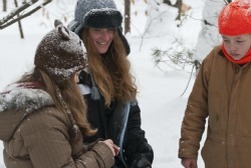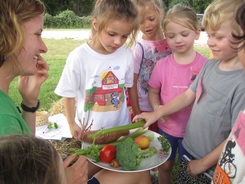|
Valerie Metzler's Inquiry of applied science learning |
Why applied Science learning?

When I initially began my inquiry, I wanted to focus on student engagement and learning in outdoor spaces. However, I was limited in my ability to take students outdoors during the long winter of 2014-2015. Needless to say, students were not thrilled about leaving the classroom to enter freezing conditions for the sake of learning. After my realization of the obstacles urban teachers face, including limited time, large class sizes, and months of frigid conditions, I realized that I wanted to focus on a spectrum of applied science learning opportunities and not limit my inquiry to outdoor learning experiences.
Increasingly, students are pressured to perform well on standardized tests and are required to memorize isolated bits of deposited information (Hilton & Honey, 2011). As I taught students and observed teachers in formal and informal settings, I realized that students were more engaged and excited about the material when it was related to their lives or when they had the opportunity to visualize and experience the content at hand. |
formational quotes to my initial inquiry“It is not half so important to know as to feel”
― Rachel Carson, The Sense of Wonder “Education is not a preparation for life; education is life itself” ― John Dewey (1897) |

Throughout my teaching experiences in environmental and food systems education, I observed students learning and growing in positive ways as they experienced scientific concepts and phenomena outdoors and when they were able to apply this content. In the 2013-2014 school year, I had the opportunity to bring a 7th grade science class outside to their school garden once a week and to incorporate components of the garden into their science curriculum. In the garden I enhanced the geology curriculum with a lesson on soil type, asking students to make soil ribbons to determine several soil types. In addition, students participated in teacher-led inquiry as they explored stomata on plant leaves and learned about the process of photosynthesis. Students also learned about the circulatory and reproductive systems of the plants and the chickens that lived next to the garden.
|
“Wonder is the mother of all science.”
― John Dewey, How We Think "Learning to Do, Doing to Learn, Earning to Live, Living to Serve." ― FFA Motto |

Once I entered the realm of teaching at my formal educational fieldwork site, I saw that there were many opportunities for hands-on learning that could be better utilized as teaching tools and smoothly integrated into the curriculum. I agree with Glynn & Muth (1994), who point out that teachers must integrate "hands-on" activities with "minds-on" approaches in order to foster both a contextualization and understanding of science content. Another goal throughout this inquiry is to identify ways to make field trips and hands-on learning opportunities more connected to students' learning in and outside the classroom.
I propose that students will be more engaged and interested in the material when they participate in hands-on, problem- or project-based, and connected learning opportunities than when they listen to teacher-led lectures. I think students will also be able to recall information more accurately when they are exposed to real-life learning situations.
In order to direct my inquiry, I used behavioral observations of students (notes and videos), student feedback, and student-made products to assess the effects of real-life experiential learning opportunities. I also interviewed an informal educator about students’ responses to outdoor or indoor real-life experiential learning opportunities and delved into literature on teaching and learning through modeling, problem-based learning, outdoor fieldwork, connected and hands-on learning experiences.
Valerie Metzler
I propose that students will be more engaged and interested in the material when they participate in hands-on, problem- or project-based, and connected learning opportunities than when they listen to teacher-led lectures. I think students will also be able to recall information more accurately when they are exposed to real-life learning situations.
In order to direct my inquiry, I used behavioral observations of students (notes and videos), student feedback, and student-made products to assess the effects of real-life experiential learning opportunities. I also interviewed an informal educator about students’ responses to outdoor or indoor real-life experiential learning opportunities and delved into literature on teaching and learning through modeling, problem-based learning, outdoor fieldwork, connected and hands-on learning experiences.
Valerie Metzler
